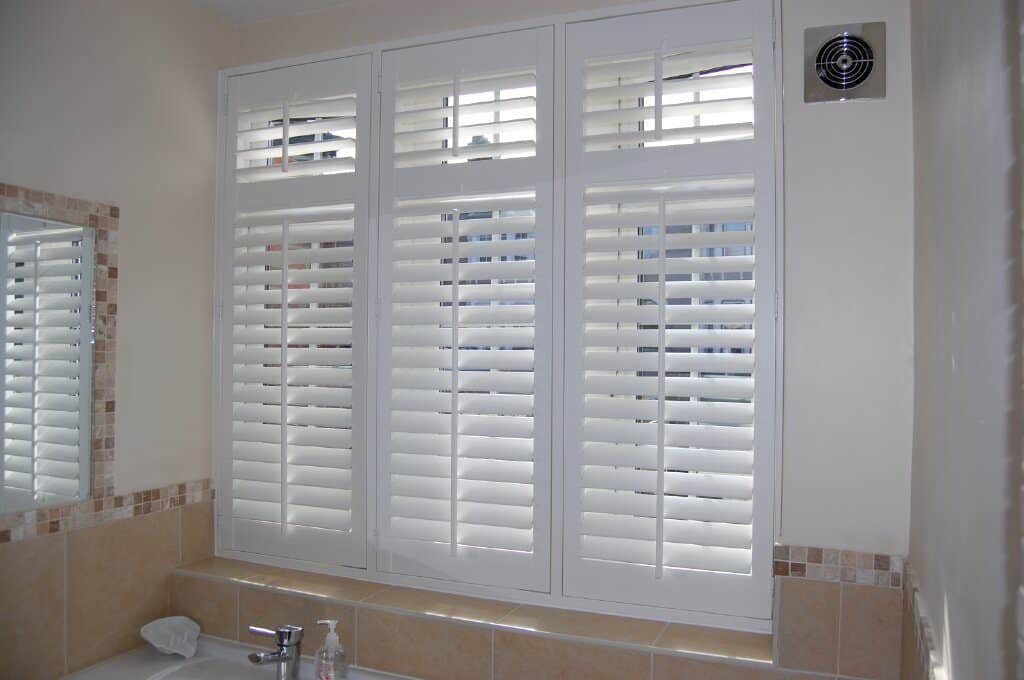Menu

In the world of interior window shutters, the two most used materials are wood and medium-density fibreboard (MDF). But what is the difference between the two? What are the advantages and disadvantages of each, and which should you opt for in your home? Our customers often ask us these questions, and their final decision between wood or MDF shutters usually comes down to a few simple considerations.
Note: Although MDF and wood are the primary materials used to manufacture window shutters, there are many more materials to consider (not to mention many kinds of wood). As such, you can read our blog post on the best materials for window shutters for a more inclusive list. But for now, we will weigh the differences, pros, and cons of hardwood vs. MDF shutters to help you decide which of the two is best suited to your requirements.
Wood is a highly adaptable and all-purpose material, with properties and features influenced by several factors, including the tree type. The specific qualities of wood vary depending on the tree’s growth patterns, the age of the wood, and the environmental conditions in which it was grown, resulting in diverse textures, colours, and grain patterns.
When choosing the best wood for window shutters, there are several aspects to consider, including the room where you will install the shutters, the design and colour scheme of the room, the width of the window frame, and the purpose of fitting shutters. The natural features of wood (grains, textures, and colours) give window shutters a unique look and feel.
The most popular types of wood used for window shutters are basswood and hardwood.
Basswood is one of the woods most often used in shutter making. Basswood is a smooth and fine-grained wood that comes from lime trees. Due to its popularity in the industry and high manufacturing standards, basswood shutters come at a lower price range without sacrificing quality.
Our Boston shutters deliver the benefits of beautiful basswood and come in a spectrum of bright and airy finishes that complement the material’s texture. Basswood is a relatively soft and light wood, and these shutters are made with mortise and tenon joints that control warping and guarantee utmost durability.
Hardwood refers to natural wood harvested from deciduous trees. The qualities of the material, such as strength or texture, depend on the species of tree.
The general hardwood category comprises woods from trees that shed their leaves in the winter and grow almost worldwide. Tropical hardwoods grow faster than those in colder countries, making them a good option for furniture.
However, in UK homes, due to accessibility, slower-growing hardwoods are mainly used. These include oak, teak, mahogany, birch, cherry, and beech. Since these woods come from slow-growing trees, they are among the most robust materials for window shutters. As such, hardwood is used to make shutters with both durability and elegance in mind.
Wood from the poplar tree is another popular choice for shutters. Although a hardwood, it is lightweight and easy to work with. It is also resistant to warping and shrinking, making it an ideal choice for shutters often exposed to strong sunlight.
Pinewood is not a hardwood, but a softwood known for its affordability and versatility. But it is extremely hard for a softwood. Like Poplar, pine is also relatively lightweight and easy to work with.
Ultimately, the choice of wood for your window shutters will depend on your personal preferences, budget, and home.
Our shutters come in various woods and finishes, with fine-grained basswood (explicitly sourced for use in shutters) being the most requested among our local clientele in Kent and London.
Stronger than MDF – The oak table you sat at for years in your grandparent’s house, which your parents still use after decades, is not a stroke of luck. Natural harvested from trees is exceptionally strong and long-lasting. Constructing companies used wood in bridge construction in the past, which stands as a testament to the strength of hardwood. Its characteristics vary depending on the tree species from which it was harvested. Due to their stability, wooden shutters are the logical choice over MDF for larger openings where a sturdier fixture is required, for example, in doorways and bay windows.
Natural and organic – the different grains and wood finishes add charm and authenticity to your shutters, especially when incorporated into traditional interiors. You simply can’t compare the look of hardwood to MDF when it comes to appearance, and each item made with wood is unique. While some may say they are not as attractive, basswood and pine are ideal choices if you want aesthetically pleasing home decor at an affordable price.
Increase the value of a property – Any furniture made from solid wood can fetch a decent price when resold. Therefore, choosing natural wood shutters is a wise investment if you think you will eventually sell your home. MDF shutters, on the other hand, although a great selling point for buyers, will not significantly increase the value of a property.
Lighter than MDF – Because wood is lighter than MDF, MDF shutters are easier to use (especially in the case of tracked shutters, which open and close horizontally) and easier to install, which means lower labour costs.
Distinct types of wood – with options including pine, oak, teak, cedar, and many more, wooden shutters come with various individual qualities and benefits. Wood is available in an extensive range of colours and finishes, with enough variation to suit any home interior style. In contrast, MDF shutters come only in various shades of white. During our free initial consultation, we can discuss the pros and cons of each wood type with you to help you make an informed decision.
Match Other Decor – Because wood is used extensively in furniture making and other home decor, You can match your shutters to other furniture such as bookcases, chests of drawers and cabinets, and smaller accessories like lamps, shelves, picture frames, etc.
Pricier than MDF – Hardwood shutters fall under a higher price range than MDF window shutters due to the high quality of the material, which may pose a problem for those on a limited budget.
Susceptible to humidity – While this mainly applies to unstained wood, wood shutters are not always suitable for humid rooms, although water resistance largely depends on the tightness of the wood grain. When in damp conditions, mould may damage wood over time.
Temperature sensitivity – In areas where there are frequent fluctuations in temperatures, warping or splitting may be a problem. When temperatures change quickly, natural wood expands and contracts, which may require repairs.
MDF stands for Medium Density Fibreboard. MDF is an engineered wood composite product made from the residue of industrial milling, such as sawdust, wood chips or shavings.
The first step to produce medium-density fibreboard (MDF) involves pulping the wood chips or shavings mechanically. This breaks them down into individual fibres through a refining process. The resulting fibres are then dried and blended with resin. Wax is often added to increase the board’s durability. These fibres are then shaped into a mat, which is compressed and heated in a hot press. This process creates a rigid, uniform board that we can use in a variety of applications.
Our MDF shutters are finished with a plastic coating, giving them a slightly glossy look.
Durability – since MDF is made of various woods and topped off with a plastic coating, MDF window shutters benefit from resilience to scratches and dents. Its unique structure makes MDF resistant to warping and splitting. It can withstand intense humidity because each louvre or sheet expands or contracts as a single unit and retains its original shape.
Natural appearance – while not harvested from trees, many of our customers cannot distinguish MDF shutters from more expensive real wood options at a glance, making them a realistic alternative.
MDF is easier to clean – since they are manufactured with a plastic coating instead of a painted finish, MDF window shutters usually only require a quick once-over wipe.
Cheaper than wood – although the lower price isn’t apparent in their appearance, it certainly makes MDF an excellent choice for people on a budget.
Fewer colours compared to wood – our MDF shutters come in five shades of white, which may deter those looking for a broader palette or darker tones.
Heavier than wood – Many people are surprised to discover shutters made from MDF are heavier and more complicated to install than natural wood. Their weight could threaten the integrity and functionality of the covering (we can advise you on this).
Limited placement options – being somewhat less flexible when it comes to intricate shapes and designs, MDF shutters aren’t suitable for circular or triangular windows.
Without knowing the full details, when asked to choose a material between MDF and solid wood, most people would choose the latter if budget was not an issue.
But as you have probably realised by now, there is no “best” when comparing wood and MDF. The choice between MDF and harvested wood shutters usually boils down to a customer’s aesthetic preferences, how and where they intend to install shutters and their price range.
Having said that, if you are a fan of traditional home design, the cost is not a significant concern, then hardwood shutters are likely to be the material you will choose.
On the other hand, we should note that rapid technological advances have made medium-density fibreboard much more robust, cheaper, and more aesthetically appealing than it used to be.
To summarise, interior window shutters made with MDF, or natural wood are an excellent addition to a kitchen, living room or bedroom.
Contact Us
Are you still spoilt for choice and unsure which material is the best solution? Don’t worry; our team of window shutter specialists are here to help! For help to discern which material best suits your specific interior design preferences and budget, feel free to contact Diamond Shutters, and a member of our friendly team will be happy to help.
Kevin Addington is the founder of Diamond Shutters. He has more than 20 years of experience in the purpose-made joinery sector. Kevin launched his company in 2008, and along with his team, has become one of the leading shutter installers in London and the South East, supplying and fitting window shutters for domestic and commercial customers.
“Diamond shutters are committed to an eco friendly environment and all the cardboard we use through our manufacturing process is fully recyclable.”



FINANCE STATEMENT
Any late or missed repayments may have serious consequences and your credit rating may be affected which could make it more difficult to obtain credit in the future. Offered subject to status and successful credit assessment.
Interest Free Options available please contact us for further details.
Diamond Shutters Ltd trading as Diamond Window Shutters acts as a credit broker and not a lender, offering credit products provided by Specialist Lending Limited (trading as Duologi). Diamond Shutters Ltd is a limited company registered in England and Wales under number 05403049 at the registered address: 132 Station Road, Sidcup, DA15 7AB
Copyright © 2024 Diamond Window Shutters | Web Design By Smoking Chili Media